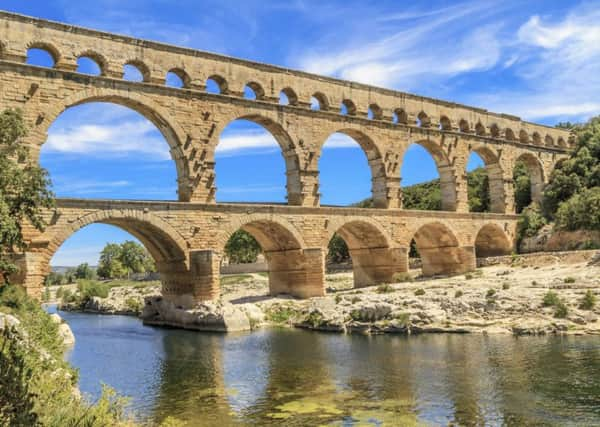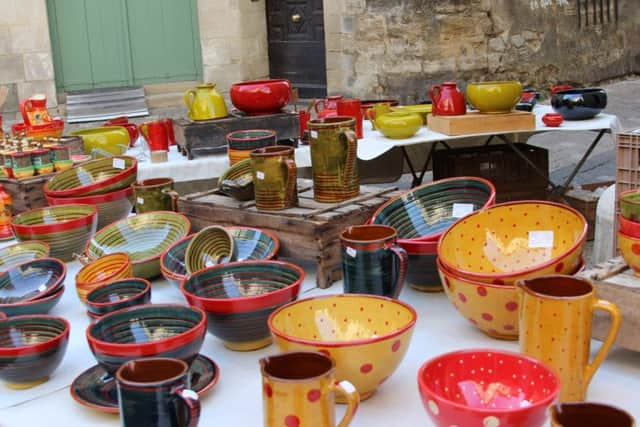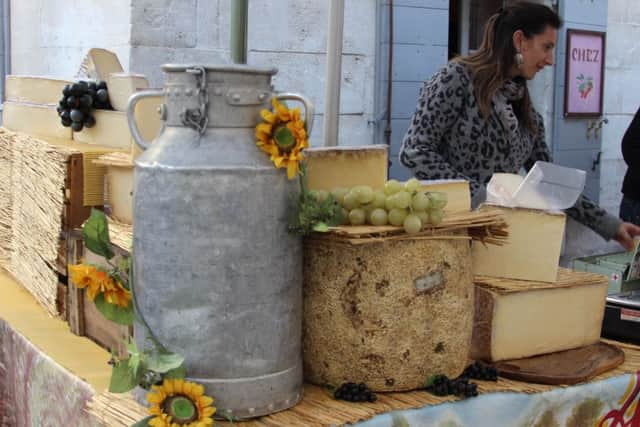Travel: Exploring France's Languedoc-Roussillon region
This article contains affiliate links. We may earn a small commission on items purchased through this article, but that does not affect our editorial judgement.


Mammoth, mighty, monumental, majestic – the Pont du Gard is indeed a blockbuster. Of course, I had seen many pictures of this fantastic feat of Roman engineering, but it is still an unforgettable experience to see it yourself for the first time. It was built in AD45 when the colony of Nemausus, nowadays known as Nîmes, was growing. Unfortunately the townspeople had no water – the nearest supply was in Uzès. The problem was, Uzès was some distance away at the other side of the Gardon river. Who but the clever Romans would have thought of bringing water to the population of Nîmes by building an aqueduct? Comprising three tiers of arches standing 50m high and measuring 360m across the top at its longest, the construction is a magnificent achievement built to last and, what’s more, without even a daub of cement.
We were based in Uzès, a small, pretty town which always seems to be enveloped in a golden glow because of its pale, porous limestone buildings. It’s only 15 minutes by car from the Pont du Gard and once upon a time was an important trading centre for linen, silk and, perhaps rather oddly, liquorice. There is plenty to see and do here, particularly on Wednesdays and Saturdays when the market comes to town and the Place aux Herbes bursts into life with animated shoppers. Masses of stalls are stacked with everything you can imagine – herbs that smell of sunny hillsides, fat strawberries, huge oysters, shiny peppers, bowls of crunchy green olives while stacks of tempting cheeses vie for attention in bright displays of creamy white, orange and blue. One stallholder, a shiny-faced lady with a giant black pan, was stirring a bubbling paella while local nuns were doing brisk business selling their own honey and organic wines. Not that it was all food of course, other stall holders offered a multitude of wares to potential buyers, including handmade soaps and scented oils, scary looking knives, sundry household knick-knacks, antique clocks, flowers, clothes, books and ceramics – the region is famed for the latter.
Advertisement
Hide AdLater that day, while wandering round Uzès, I happened upon an enclosed medieval garden, its entrance by way of a narrow, cobbled alleyway. It is divided into sections – a herbarium, vegetable garden and an area devoted to poisonous plants, each marked with a red dot. It is a peaceful place to linger a while and a really nice touch is that visitors get a complementary tisane, herbal tea, before they leave – mine was liquorice and verbena. Also in Uzès is Le Duché, the ducal palace, where the dukes of Uzès, France’s oldest ducal peerage, have lived off and on for around 1,000 years. The family crest is outlined in colourful tiles on the roof and their red-and-yellow-striped flag flies from the tower when any of its members are in residence.


Next morning we headed for Nîmes, a town famous for its Roman monuments, in particular for its amphitheatre which played a starring role in the film Gladiator. Inside the Musée du Vieux Nîmes, a whole area is devoted to the city’s most famous export, the robust fabric known as serge de Nîmes, traditionally worn by agricultural labourers. Nowadays, of course, everyone knows the cloth as denim. The town’s most famous sight meanwhile, is a cleverly preserved temple, all stately columns and triumphal steps. This is the Maison Carrée, built around AD5 to honour Emperor Augustus’ adopted sons. Despite the name, the Maison Carrée (Square House) is rectangular. Right across the street, in complete contrasting style, the Carré d’Art is a conspicuous glass and steel building designed by architect Sir Norman Foster which houses the municipal library and the Musée d’Art Contemporain with exhibitions covering art from the 1960s onwards.
Also on our itinerary was the medieval walled town of Aigues-Mortes built on the marshlands of Europe’s largest river delta. Entirely unperturbed by the centuries that have passed, this is a remarkable town with streets laid out in grids, although, as you might expect, it’s hugely touristy, particularly in summer. Lagoons at the southern end are pinky red in colour because of the high concentration of salt therein, and look quite bizarre. Just beyond them are mountains of salt – the town’s role as a provider of salt goes back forever and trains chug back and forth to take tourists round the marshes. The lagoons teem with pink flamingoes and there are rice paddies here too, while fields of white Camargue horses, sometimes called “horses of the sea”, converge to make a colourful scene. The horses are dark when they are born, only turning white when about four years old. These hardy beasts, not affected by the heat, swim in the sea, gallop across fields, trot on the sand and live rather a daredevil existence. Nowadays more care is taken of them; they get vet and farrier visits and fortunately are less likely to be overworked than they once were.
Any visit to Languedoc-Roussillon would be incomplete without experiencing Montpellier, the region’s capital. With guide Virginie, who also acted as our expert chauffeur throughout, we started our tour in the main square officially called the Place de la Comédie, but generally locally known as as L’Oeuf (the egg) because of its oval shape. Montpellier is known for its lively social scene, but then it could hardly be otherwise since 40 per cent of its population is under 30. It has oceans of style, even the trams are ultra fashionable (they were designed by Christian Lacroix). Shopaholics may like to note that although many French shops are closed on Mondays, Montpellier’s stay open.
For those with lots of cash to splash, high-end stores including Cartier are on the main streets leading away from the Place de la Comédie, but if you don’t want to frighten your wallet, the Polygone shopping centre, also near La Comédie, is filled with an array of French chain stores including Galeries Lafayettes.


And of course the area’s wine has to be mentioned. With an average of 300 sunny days a year, Languedoc-Roussillon is one of the world’s great wine producing regions with about 300,000 hectares of vines, four times that of Bordeaux.
Advertisement
Hide AdWine festivals throughout the year celebrate the harvest or the beginning of the growing season. It seems the residents take advantage of any excuse to have a party with local food, wine, music and dancing. We visited Paul Mas vineyard, run by fourth generation vintner Jean-Claude Mas where, after a delicious lunch and some more-ish wines, we were whizzed round the vineyards in a quad vehicle driven by Julie Billod, head of communications. We bumped along narrow tracks and up steep hills, while Julie waved enthusiastically at the vines and shouted above the noise of the engine to explain what they were. We didn’t mind that we arrived back a little dusty and had to leave straight away for the airport – it was a perfect end to a lovely trip.
• Fly from Edinburgh to London Gatwick and on to Montpellier with EasyJet (www.easyjet.com). Accommodation in Uzès: Hotel Entraigue (www.hotel-entraigues.com) and Hotel La Maison d’Uzès (www.lamaisonduzes.fr). For more on the area see en.destinationsuddefrance.com, www.uzes-tourisme.com and www.ot-nimes.fr